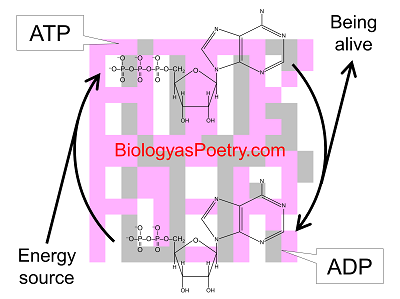∞ generated and posted on 2016.08.25 ∞
The primary energy-carrier molecule found in cells.
ATP stands for Adenosine TriPhosphate where adenosine is a ribonucleic acid (i.e., RNA). Contrast with ADP, or Adenosine DiPhosphate.
ATP carries three phosphate groups. What are commonly referred to as "high-energy bonds" are found between these three groups, which can be abbreviated as Pi~Pi~Pi where Pi stands for "inorganic phosphate".
Breaking of the bonds between Pi groups, with these bonds represented as ~, is a process of hydrolysis. The product of this ATP hydrolysis often is ADP. It is also possible for hydrolysis to result in the simultaneous cleavage of two phosphate groups, resulting in the generation of a combination of what is known as AMP (Adenosine MonoPhosphate) in combination with what is known as pyrophosphate (Pi~Pi). A process similar to this is seen particularly during transcription, with a related process seen also during DNA replication.

Figure legend: The structure of ATP, Adenosine TriPhosphate. Note the three phosphate groups, linked together, versus ADP's two. Note also the nitrogens (N) found in adenosine, a nitrogenous base. The corner of each of the geometric shapes represents a carbon atom and that each carbon atom has four bonds to it, with any missing bonds assumed to be hydrogen atoms that are not shown.

Figure legend: The structure of ADP, Adenosine DiPhosphate. Note the two phosphate groups, linked together, versus ATP's three. Note also the nitrogens (N) found in adenosine, a nitrogenous base. Note that the corner of each of the geometric shapes represents a carbon atom and that each carbon atom has four bonds to it, with any missing bonds assumed to be hydrogen atoms that are not shown.

Figure legend: Energy coupling in organisms is typically illustrated based on the generation and hydrolysis of ATP. Energy generation is driven by whatever an organism utilizes as an energy source whereas the ATP, once produced, is used to power the organism. The figure presented shows the structures of ATP and ADP but not the water molecule involved in hydrolysis as well dehydration synthesis, nor the inorganic phosphate (Pi) that is added to ADP to produce ATP.
ATP is a very temporary storage molecule of chemical energy and the primary immediately available form of chemical energy found within cells.